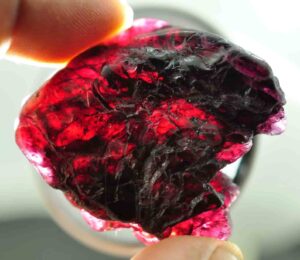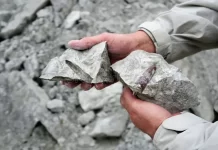
Credit: supremgem/etsy
Introduction
Gemstones have captivated humans for millennia with their beauty, rarity, and unique qualities. While there are countless gemstones known to us today, one gemstone stands out as the most unique and intriguing: Painite. Discovered in 1951, Painite is an incredibly rare and enigmatic gemstone whose formation is still not fully understood. In this article, we will explore the fascinating geological story of Painite, examining its formation process and the characteristics that make it the most unique gemstone in the world.
Discovery and Rarity
Painite was first discovered in Myanmar (formerly Burma) by British gemologist Arthur C.D. Pain, after whom the gemstone was named. For decades, only a few specimens were known to exist, making it one of the rarest gemstones on Earth. In fact, the Guinness World Records once listed Painite as the world’s rarest mineral. However, in recent years, more Painite deposits have been discovered, though the gemstone remains exceedingly rare and highly valuable.
Formation and Geological Context
Painite is a borate mineral with the chemical formula CaZrB(Al9O18). Its formation is thought to occur in metamorphic rocks, particularly in the contact zones between marbles and boron-rich granitic pegmatites. These pegmatites are formed when molten rock cools and crystallizes slowly, allowing the formation of large crystal structures. The presence of boron, an essential element in Painite’s composition, is a key factor in its formation.
Painite’s unique crystal structure is characterized by a hexagonal system, making it visually distinct from other gemstones. Its color varies from reddish-brown to dark brown and sometimes exhibits a slight orange hue. This unique gemstone also exhibits pleochroism, a phenomenon where the gemstone displays different colors when viewed from different angles.
The formation of Painite is a complex process that is not yet fully understood. Several factors are believed to contribute to its rarity, including the specific geological conditions required for its formation, the scarcity of its constituent elements, and the unique combination of pressure and temperature needed for the crystal to grow. Furthermore, Painite’s formation is thought to be associated with the presence of other rare minerals such as ruby, sapphire, and spinel, which are also found in the Mogok region of Myanmar where Painite was first discovered.
Significance and Value
The rarity and uniqueness of Painite make it a highly sought-after gemstone among collectors and connoisseurs. While its hardness, measured at 8 on the Mohs scale, makes it suitable for use in jewelry, its extreme scarcity means that most Painite specimens are preserved as mineral specimens in private collections or museums.
In recent years, Painite’s value has increased exponentially as its rarity has become more widely recognized. As more deposits are discovered, and our understanding of its formation process deepens, the fascination with this enigmatic gemstone is likely to continue. Painite serves as a testament to the wonders of Earth’s geological processes, providing a tangible reminder of the incredible diversity and beauty of the natural world.
Conclusion
Painite’s unique characteristics, geological context, and rarity make it the most unique gemstone in the world. Its formation process, while still not fully understood, is a fascinating story that highlights the complexity and wonder of Earth’s geological processes. As we continue to explore and uncover the mysteries of this exceptional gemstone, Painite will undoubtedly continue to captivate and inspire both scientists and gem enthusiasts alike.










